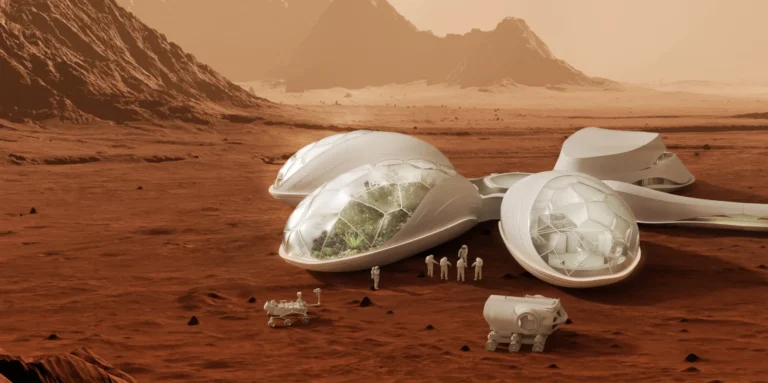Imagine waking up in the morning and walking to your kitchen to make your daily cup of coffee: You leave your living quarters and walk past an area blooming with vertically farmed crops. After breakfast, you head into the workroom and robot station. Just outside the airlock, you can see that you’re completely surrounded by red sand.
If this sounds like living on Mars, that’s exactly the point. Except it’s not Mars; it’s the Johnson Space Center in Houston, Texas, where NASA is based.
Earlier this summer, four volunteer crew members entered the Mars Dune Alpha, a 1,700 square foot 3D-printed structure that mimics the internal and external conditions of a real-life expedition to Mars. They’re spending 378 days in the facility, which includes a workspace, private living quarters, a medical center and a kitchen, as well as areas for fitness, recreational activities and crop growth. The structure is surrounded by the “sandbox”, an area of red-dyed sand that replicates the terrain of Mars.
The mission is part of NASA’s Crew Health and Performance Exploration Analog (CHAPEA) program and was implemented with the goal of understanding and improving the physical and psychological hardships associated with living in space for extended periods of time. Another objective of the program is to study the challenges of growing food in low-gravity environments, and determine the adjustments needed to provide astronauts with the proper nutrition to sustain them during their journey. These insights will be valuable in developing and enhancing technological systems to support sustainable and reliable space agriculture necessary for advancements in space travel in the future.
The mission, which began in June 2023, is the first in a series of three year-long missions in the Mars Dune Alpha acting as dress rehearsals to simulate the experience of living in a future surface habitat on Mars.
Planning for a multi-planetary existence
That future could be closer than many of us realize. As close as a decade from now, according to Interstellar Lab’s founder Barbara Belvisi. And she should know as well as just about anyone here on Earth.
“I’m a strong believer that Mars is going to be around the early 2030s,” Belvisi said last year in a wide-ranging interview with the Dassault Systèmes blog. “There are some ideal planet placements in orbit to ensure it’s six months and not two years to get there, and I think it’s in 2032 that there is a window. I believe we can achieve that.”
At Interstellar, Belvisi and team are focused on producing modules that allow for habitation and agriculture on other planets as well as on Earth, with biodiversity conservation as a key emphasis. Their goal: preserving life on Earth while expanding it into space.
A year before those volunteers entered the Mars Dune Alpha, we got a glimpse at what a multi-planetary station could look like last June when Interstellar began production on its BioPod, an autonomous agricultural module that can facilitate plant growth in any environment on Earth.
These climate controlled biofarms can produce up to five tons of food annually and accommodate the development of over 300 plant species. Interstellar’s BioPod promotes sustainability through its closed-loop environment, which relies on less water, energy and resources in comparison to traditional agricultural processes.
Utilizing CATIA and SIMULIA on Dassault Systèmes’ 3DEXPERIENCE platform, Interstellar created virtual twins and simulations of the BioPods that aided in the overall development and enhancement of the final product. BioPods will enable food production in outer space to sustain astronauts, but were also developed with the intention of eventually supporting larger populations of people.
Along with their BioPods, Interstellar is developing Experimental Bio-Regenerative Station (EBIOS) structures to operate as sustainable villages that can accommodate up to 100 residents in a carbon-neutral setting. With the ability to operate on Earth as well as in space, EBIOS have the potential to improve the quality of life for communities of people in harsher climates and terrains. Similar to the Mars Dune Alpha, EBIOS can function as their own cities by offering all of the resources and structural amenities that are vital to accommodating human residency in a self sustained facility.
As growing food off planet presents its own set of unique challenges, Interstellar and CHAPEA aren’t the only initiatives taken towards advancing agricultural systems in deep space. Over the years, NASA and the European Space Agency have been investing significant time and resources into gaining a better understanding of how food grows in space.
NASA and Japan’s Space Foodsphere program is working with several innovative urban farming startups to apply their vertical farming solutions to growing food in space. Among these startups are a few of our customers, such as PlantX and Freight Farms as well as Futura Gaïa, which is supported by the 3DEXPERIENCE Lab.
Interstellar Labs has collaborated with the Kennedy Space Center, one of NASA’s field centers in Florida, to develop new watering systems in order to overcome the challenges of watering plants in sensitive low gravity environments where water behaves differently.
While we look to the skies and prepare for our future in Space, the process of resolving challenges of space travel and living off-planet can also lead to solutions that help cope with food security and the lasting impacts of climate change here on Earth.
As we work towards addressing challenges of the future and the present by adapting cities towards greater sustainability, it’s possible that some of the answers might ultimately be found on the Red Planet…or its doppelganger in Texas.
Read More

